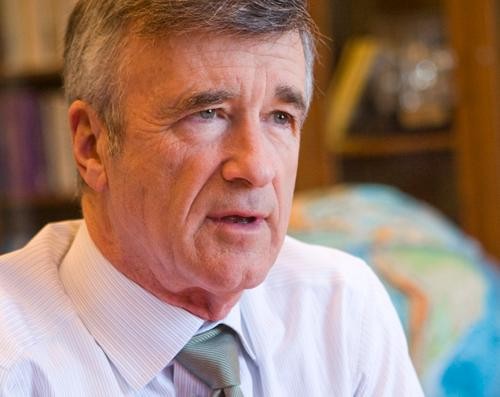Robert N. Shelton, a former president of the UA and physicist, has been appointed president of the Giant Magellan Telescope Organization (GMTO) effective Feb. 20.
The GMTO is in the process of building the world’s largest telescope, with the help of 11 other partners, including the UA.
“I think this is going to be a fantastic project for science and in particular for the UA,” said Jeffrey Kingsley, associate director for Steward Observatory. “This is probably going to provide the next wave of science and astronomy at the university for the foreseeable future, so I think it keeps the UA at the forefront of astronomy and science.”
Shelton, who was president of the UA from 2006-2011, went on to become president of the Research Corporation for Scientific Advancement. Shelton is also the former executive director of the Arizona Sports Foundation and provost and executive vice chancellor of the University of North Carolina, Chapel Hill.
“I think it’s really critical for American astronomy to stay in the forefront and that we successfully build this Giant Magellan Telescope,” Shelton said.
The Giant Magellan Telescope (GMT) is truly one-of-a-kind. Not only will it be the largest optical observatory ever built, but all the mirrors are being built here at UA.

“GMT and its partners have proposed a design that is based on the technology that we put together at the UA and its Magellan partners,” Kingsley said. “We believe we can put the telescope together relatively quick and produce a very large collecting area with high resolution and ultimately have adaptive optics on it do high-resolution imaging.”
According to Shelton, the process of creating the 8.4-meter mirrors, which was originally pioneered by UA astronomy professor Roger Angel in 1980, is unique to the UA. The mirrors are manufactured in the Richard F. Caris Mirror Laboratory located under Arizona Stadium.
Of the seven mirrors needed for the telescope to function, four have already been completed and are in the polishing stages, with production on the fifth mirror scheduled to begin this year, Kingsley said.
Once the telescope is completed, the real fun will begin.
RELATED: Featured Science: Mirror lab builds cutting edge telescope parts
“We’re going to discover things we can’t even imagine,” Shelton said. “There are a whole lot of fundamental astronomy questions it’ll be able to answer or give us insights into.”
Shelton went on to mention some of the areas the telescope will allow us to study, including dark matter, the formation of galaxies and black hole growth.
“I think overall this telescope, when it’s finished, will bring to people all over the Earth the kind of inspiration that you see from the Hubble [telescope],” Shelton said.
As president of the GMTO, Shelton will have the opportunity to be closely involved with the project’s partners and the scientific community. He said he hopes to focus on fundraising, communicating with the other institutions involved and making sure the project stays on track for its projected date of completion in 2024.
“I interacted with [Shelton] early on when he became president of the university, and he has been a strong supporter and sponsor of the GMT project, he was a key member in getting the GMT organization formed,” Kingsley said.
RELATED: UA research finds evidence supporting the existence of a ninth planet beyond Neptune
The UA is one of 11 partners on the project, including distinguished institutions such as the Smithsonian Institution, the Korean Astronomy and Space Science Institute and Harvard University.
“When you get to be president of a great university like Arizona, you also make international contacts,” Shelton said, referring to the partners in the GMTO. “So being at Arizona afforded me the opportunity to get to know these kinds of folks, and now coming in I’m not an unknown quantity to work with them.”
The new president plans to focus much of his attention on fundraising. He said the GMTO board authorized a budget of a little over a $1 billion for the project—a goal the GMTO is nearly halfway to achieving, making fundraising a top priority.
He went on to say his time as president of the UA has prepared him for this new position.
“I think it’s the contacts that you make, understanding what you need to do on big projects, although each one is unique, and then finally in these positions you learn that you don’t get anything done without a great team to work with, and the ability to work in a team is very important,” Shelton said.
Those who worked with Shelton speak highly of his capabilities.
“I think his passion in physics and astronomy and his background in history is going to be fantastic for the GMT project, and I think he’ll make a big difference in realizing the GMT project,” Kingsley said.
The GMT is located at the Las Campanas Observatory in northern Chile and is on track to be completed in 2024.
Follow Hannah Dahl on Twitter.









